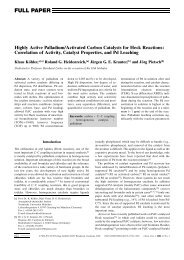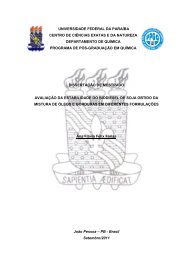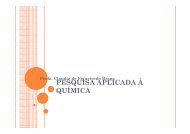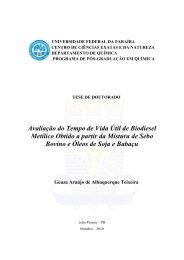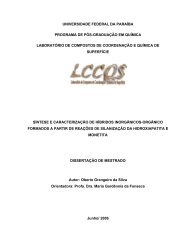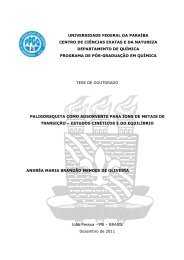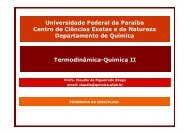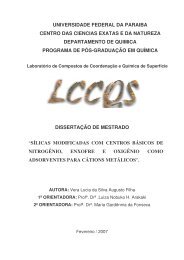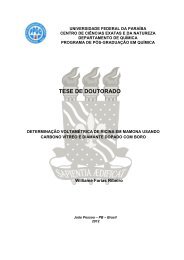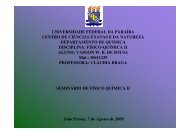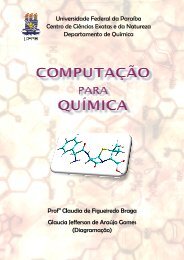RESUMOJoão Jarllys Nóbrega <strong>de</strong> Souza; Orientadores: Profª. Drª. IêdaMaria Garcia dos Santos, Prof. Dr. Ary da Silva Maia.Este trabalho envolveu a síntese <strong>de</strong> um óxido <strong>com</strong> a estrutura perovskita (ABO 3 ),o estanato <strong>de</strong> estrôncio (SrSnO 3 ), <strong>com</strong> estrutura ortorrômbica <strong>com</strong> grupoespacial Pbnm, usando o método dos precursores poliméricos. Este materialapresenta aplicações <strong>com</strong>o capacitores, sensores <strong>de</strong> gases <strong>com</strong>o o CO, NO x ,H 2 , umida<strong>de</strong> e atualmente vem sendo estudado <strong>com</strong>o catalisador. No início<strong>de</strong>ste trabalho, o SrSnO 3 puro e dopado <strong>com</strong> 10 % em mol <strong>de</strong> níquel(Sr 0,9 SnNi 0,1 O 3 , SrSn 0,9 Ni 0,1 O 3, Sr 0,95 Sn 0,95 Ni 0,1 O 3 ) foi caracterizado, fazendo usoda análise térmica (TG/DTA), espectroscopia <strong>de</strong> infravermelho (IV),espectroscopia na região do Ultra-violeta - visível, espectroscopia RAMAN,Difração <strong>de</strong> Raios-X (DRX) e área superficial pelo método <strong>de</strong> BET. A ativida<strong>de</strong>catalítica dos materiais <strong>não</strong> suportados foi avaliada na reação <strong>de</strong> redução domonóxido <strong>de</strong> nitrogênio (NO) <strong>com</strong> monóxido <strong>de</strong> carbono (CO) seguida <strong>de</strong>caracterização por DRX, IV e Raman. O material calcinado a 800°C, apresenta oSrCO 3 <strong>com</strong>o fase secundária, sendo que a substituição do Sr <strong>2+</strong> pelo Ni <strong>2+</strong> reduz aformação <strong>de</strong> carbonato. A dopagem <strong>não</strong> alterou significativamente a or<strong>de</strong>m alongo alcance mas aumentou a <strong>de</strong>sor<strong>de</strong>m a or<strong>de</strong>m curto alcance. O sistema <strong>com</strong>melhor <strong>de</strong>sempenho catalítico (SrSn 0,9 Ni 0,1 O 3 ) obteve conversões <strong>de</strong>aproximadamente 90% <strong>de</strong> CO a CO 2 e 85% <strong>de</strong> NO a N 2 . Na segunda parte dotrabalho os catalisadores foram suportados (10% em massa, fase ativa/suporte),na anatase, gama alumina, céria e zircônia, a partir da resina obtida pelo métododos precursores poliméricos, <strong>com</strong> caracterização pelas técnicas <strong>de</strong>scritasanteriormente. Buscou-se, <strong>de</strong>ssa forma, avaliar o efeito do suporte na ativida<strong>de</strong><strong>de</strong>sta perovskita nas mesmas condições reacionais. Foi possível confirmar a<strong>de</strong>posição do catalisador sobre todos os suportes, sendo a análise dificultada porse tratar <strong>de</strong> um filme na superfície do pó, às vezes <strong>com</strong> sobreposição <strong>de</strong>picos/bandas.Palvras-chave: SrSnO 3 , perovskita, método dos precursores poliméricos,suportes, redução catalítica <strong>de</strong> NO.v
ABSTRACTJoão Jarllys Nóbrega <strong>de</strong> Souza; Advisors: Profª. Drª. Iêda MariaG. Santos, Prof. Dr. Ary da Silva Maia.This work involved the synthesis of an oxi<strong>de</strong> with perovskite structure (ABO 3 ),the strontium stannate (SrSnO 3 ), with orthorhombic structure, space groupPbnm, by the polymeric precursor method. This material has been applied ascapacitor, sensor for gases as NO, CO, H 2 , humidity and it is actually beingstudied as a catalyst. At the beginning of this work, pure SrSnO 3 and dopedwith 10 mol % of nickel (Sr 0,9 SnNi 0,1 O 3 , SrSn 0,9 Ni 0,1 O 3, Sr 0,95 Sn 0,95 Ni 0,1 O 3 ) werecharacterized by thermal analysis (TG / DTA), infrared spectroscopy (IR),Ultraviolet-visible spectroscopy (UV-Vis), Raman spectroscopy, X-ray diffractionand surface area by BET method. The catalytic activity of the non-supportedmaterial was evaluated in the reduction reaction of nitrogen monoxi<strong>de</strong> (NO) bycarbon monoxi<strong>de</strong> (CO), followed by characterization by XRD, IR and Ramananalysis. The material calcined at 800°C presented SrCO 3 as secondary phase,with a reduction in its intensity when Ni <strong>2+</strong> replaces Sr <strong>2+</strong> in the lattice. Doping didnot lead to a meaningful change in the long range or<strong>de</strong>r by increased the shortrange or<strong>de</strong>r. The system best catalytic performance (SrSn 0,9 Ni 0,1 O 3 ) achievedapproximately 90% of conversion of CO into CO 2 and 85% of NO into N 2 . In thesecond part of the work catalysts were supported (10% mass, the active phase/support) on anatase, gamma alumina, ceria and zirconia, using the resinobtained by the polymeric precursor method, with characterization as <strong>de</strong>scribedbefore. This procedure aimed at evaluating the effect of the support in theactivity of perovskite for the same reaction conditions. It was possible to confirmthe catalyst <strong>de</strong>position on all supports, in spite of the difficulty in thecharacterization as a film was formed on the pow<strong>de</strong>r surface, leading tosuperposition of peaks/bands.Key-words: SrSnO 3 , perovskite, polymeric precursor method, supports, catalyticreduction of NO by CO.vi
- Page 1: UNIVERSIDADE FEDERAL DA PARAÍBACEN
- Page 4 and 5: Dissertação de mestrado submetida
- Page 6 and 7: AGRADECIMENTOSPrimeiramente a Deus
- Page 8 and 9: SUMÁRIOLISTA DE FIGURAS ..........
- Page 10 and 11: LISTA DE FIGURASFigura 1 - Estrutur
- Page 12 and 13: Figura 45 - Micrografias do sistema
- Page 16 and 17: INTRODUÇÃO7
- Page 18 and 19: Com a crescente necessidade de dimi
- Page 20 and 21: OBJETIVOS11
- Page 22 and 23: FUNDAMENTAÇÃO TEÓRICA13
- Page 24 and 25: Tabela 1 - Atividade de algumas per
- Page 26 and 27: Figura 1 - Estrutura cristalina da
- Page 28 and 29: atenção no tocante a pesquisa par
- Page 30 and 31: eações catalíticas. Estes materi
- Page 32 and 33: ‣ controle da estequiometria de s
- Page 34 and 35: química, alta dureza e resistênci
- Page 36 and 37: METODOLOGIA27
- Page 38 and 39: estanho dihidratado, estequiometric
- Page 40 and 41: citratos. As quantidades dos reagen
- Page 42 and 43: modo a obter no final, aproximadame
- Page 44 and 45: 4.3.3.1 Parâmetros de redeOs cálc
- Page 46 and 47: foram prensadas em vácuo para obte
- Page 48 and 49: Perda de Massa (%)Perda de Massa (%
- Page 50 and 51: Absorbância (u.a)dos sistemas SrSn
- Page 52 and 53: Intensidade (u.a)o valor do “gap
- Page 54 and 55: Tabela 9 - Parâmetros de rede do s
- Page 56 and 57: Transmitância (U.A)sendo eles: 1 (
- Page 58 and 59: Intensidade (u.a)Tabela 12 - Modos
- Page 60 and 61: Conversão de NO a N 2 (%)Conversã
- Page 62 and 63: Transmitância (u.a)SrSn 0,9 Ni 0,1
- Page 64 and 65:
Intensidade (u.a)O suporte utilizad
- Page 66 and 67:
Figura 19 - Mapeamento do sistema S
- Page 68 and 69:
Intensidade (u.a)Transmitância (u.
- Page 70 and 71:
Intensidade (U.A)Intensidade (u.a)p
- Page 72 and 73:
Transmitância (u.a)Transmitância
- Page 74 and 75:
Intensidade (u.a)Intensidade (u.a)F
- Page 76 and 77:
Intensidade (u.a)Intensidade (u.a)S
- Page 78 and 79:
Figura 40 - Micrografia do sistema
- Page 80 and 81:
Intensidade (u.a)Intensidade (u.a)O
- Page 82 and 83:
Tabela 14 - Área superficial dos s
- Page 84 and 85:
Conversão de NO a N 2(%)Conversão
- Page 86 and 87:
Conversão de NO a N 2(%)Conversão
- Page 88 and 89:
6 CONCLUSÕESA síntese dos catalis
- Page 90 and 91:
BARNABÉ, A.; GAUDON, M.; BERNARD,
- Page 92 and 93:
and Actuators A: Physical, v. 173,
- Page 94 and 95:
p. 133-141, 2003.LI, J.; PAN, Y.; X
- Page 96 and 97:
MoO 3 -based HDS catalyst obtained
- Page 98 and 99:
UDAWATTE, C.; KAKIHANA, M.; YOSHIMU





